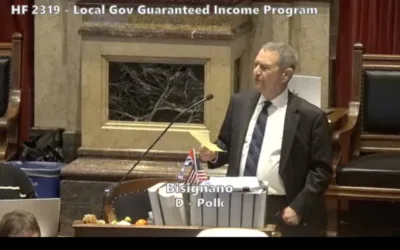
Reporting vote results takes time. And as other states are still counting their ballots late in the week, it’s a reminder that Iowa gets its numbers out rather fast and efficiently compared to elsewhere in the country.
But Linn County became a focus and frustration on Tuesday night as the second-largest county in Iowa was stuck at a low percentage of precincts reporting for hours, only finally getting the full results finished in the early hours of Wednesday morning.
Election officials in Linn County were notified around noon on Tuesday by a candidate in the county board of supervisors’ race that his entire race was left off of the ballot in Putnam Township precinct, and because of that, and several other small problems that cropped up along the way, the election results were continually delayed.
Maybe it was the full moon. Maybe it was Murphy’s Law, the one where anything that can go wrong, will go wrong.
But the blame, county auditor Joel Miller insists, is his alone.
Additionally, on Thursday morning, the Iowa Secretary of State announced Linn County had overcounted approximately 600 ballots. Miller’s office said it was the result of a screen saver locking up a computer Tuesday night.
So what exactly happened in Linn County?
Starting Line sat down with Miller on Wednesday for a wide-ranging conversation on what went wrong, how he plans to fix it, and why he’s confident in the results of the vote.
“We run free and fair elections here,” he asserted. “There’s nothing going on that’s out of the order. Do people make mistakes? Yeah, because we’re humans … Are they making it to change the vote totals or anything? No; I have full confidence in the people that we have here.”
[inline-ad id=”0″]
Missing county supervisors’ race
It was around noon on Tuesday when Miller’s office got a call from Mark Banowetz, a Republican running for a seat on the Linn County Board of Supervisors. He was voting on Election Day in his rural Putnam Township precinct and didn’t see his name, nor the name of his opponent, Democrat and State Rep. Kirsten Running-Marquardt.
“I got done and thought, ‘Hey, where’s my name at?'” Banowetz told Iowa Public Radio.
It was the first Miller had heard of the missing race. Staff scrambled to figure out if any of the other ballot styles were also missing the race (they were not), how many voters had already voted in the race (96 absentee), and more details about the race before eventually going public with the oversight in the afternoon.
“We wanted to be transparent about what was going on,” Miller said.
He said he called both Banowetz and Running-Marquardt to inform them of their options: request a recount, or contest the election, both of which they’d have the right to do and which Miller said he would support.
[inline-ad id=”1″]
But neither one is likely to occur. Here’s why:
A total of 27,141 Linn County residents voted in the county supervisor race. Running-Marquardt got 15,096 votes, while Banowetz got 11,281.
That means Banowetz needs 3,816 votes to win, but the rural Putnam Township precinct where the race was omitted only has a total of 536 registered voters (with only around 330-some voting in this election).
“It’s all math, and so that’s where we’re at,” Miller said.
He’s still working to figure out how to prevent an omitted race missed by him, his staff, and both county party chairs, all of whom reviewed each of the 111 ballot styles for this year’s election.
Miller thinks one possible added failsafe may be to send all the district’s candidates the 111 ballot styles as well, instead of simply sending them a sample of how their race will appear.
“This error occurred 45 to 60 days ago; that’s when the ballot was created,” he said. “If we would have known before Election Day, we could have notified everyone who voted absentee, sent everyone a new ballot, something.
“That was pretty catastrophic,” he added. Prior to that, “We had a very smooth election and everything seemed to be going fine.”
[inline-ad id=”3″]
Four hour delay in reporting results
The missing race was the “major distraction” and reason for the long delay in Linn County’s reporting Tuesday night.
But there were several other issues that cropped up and contributed to the more than four-hour delay:
- No cellular modems used
Miller noted that Linn County does not use cellular modems to transmit election results, like some other Iowa counties and a few other states do, because “they do not work in the northern tier of our townships in the county,” Miller said. Instead, Linn County, like the majority of counties, drives results in from all precincts.
So Linn County, Miller said, begins with a slight delay in its reporting anyway, compared to modem counties—however, there’s currently only four Iowa counties that do use that method.
“It usually takes us 90 minutes to two hours to transmit and get our results posted online,” he said.
[inline-ad id=”4″]
Going forward, he said he would “take a look at” using modems in future elections “to get the results even quicker.”
However, he said he’s skeptical about using modems to speed up the process, and it’s something the US Election Assistance Commission is encouraging election officials to phase out anyway in its new guidelines, potentially making this method moot.
- Larger amount of last-minute hospital and health care facility voter requests
Normally, Miller said his office gets around 10 ballot requests from voters who were planning to vote on Election Day but were hospitalized or found themselves in a rehabilitation center or other health care facility that day instead.
This year, he said it was four times that, and his staff fielded multiple requests from facilities. That took more staff than expected out of the office on Election Day.
- Absentee count wasn’t started on Monday
With the lower-than-expected amount of early ballots received, the decision was made to cancel a group of poll workers that were to come in on Monday and begin the process of opening ballots and counting votes.
Officials figured Tuesday’s regular staff could get it done during the day. That was, until the major “distraction,” Miller termed it, of the missing supervisors’ race.
So instead of being uploaded during the day, ready to report when polls closed like other counties in Iowa do, Miller’s team wasn’t able to get to those approximately 29,000 absentee ballots until later Tuesday.
“That was justified to do it then; those decisions were made upon past precedent,” he said. “So we’re going to look at that.”
[inline-ad id=”5″]
- Screen saver lock-up forced a restart
In the middle of absentee ballot processing on their computer, an automatic screen saver kicked in right around 11 p.m., and “that caused a restart” in the process, Miller said.
“It decided to lock up right in the middle of a big batch processing of the absentees,” he said. “That was a pretty major issue just because we were already behind.”
When the 600-ballot overcounting issue was discovered Wednesday night, Miller’s deputy commissioner of elections Matt Warfield said their best guess of why that occurred was because of the restart, as those ballots were all absentee.
Basically, staff thought the restart meant the results were not uploaded, but they actually had been, which was discovered when they compared the number of absentee ballots returned with absentee results.
That did change vote totals slightly, from Wednesday’s unofficial results to Thursday’s unofficial results (election results are not official until the canvass of paper ballots one week after every election). But Warfield said no race results changed because of the mistake.
[inline-ad id=”6″]
Secretary of State’s response
Secretary of State Paul Pate’s office sent to Starting Line their explanation of what occurred.
“The delay in reporting results Tuesday night stemmed from a programming error by the Linn County Auditor’s Office,” Pate’s office said. “Additionally, on Wednesday, November 9, the Secretary of State’s Office discovered that Linn County reported 600 more absentee ballots than had been received by their office at the time polls closed. This discrepancy was revealed during one of many reconciliation processes our office completes prior to the county and state canvasses.
“We contacted Linn County to alert them to the issue, and they went through the process of reuploading and reviewing all of their results from election night. The Linn County Auditor’s Office did not follow the basic review process recommended by the Secretary of State’s Office in multiple trainings to county auditors. Failure to verify their totals to their absentee precinct board’s election night results before publishing was the cause of the issue. It has now been corrected.”
Lessons learned
The cascading series of major issues and minor problems during the midterm election isn’t what any county auditor wants to deal with, much less one who was on the ballot for the Secretary of State position (Miller lost to incumbent Paul Pate, who expressed his frustration throughout Tuesday night with Linn County’s delays.)
“We know what the worst cases are—we just experienced about three of them yesterday,” Miller said. “Sometimes Murphy’s Law kicks in and you get surprised, and we got surprised on some things we probably shouldn’t have gotten surprised on.”
But he said he takes full responsibility for both the problems and finding solutions. Those talks are beginning now, he said.
“I wouldn’t say it’s bad luck,” he said. “We need to do better contingency planning.”
For those wanting to use his office’s mistakes as a way to spin conspiracy theories about election fraud, Miller said he hopes that he can combat that with “transparency” and being forthright about what occurred.
“I believe our biggest way to convince the election deniers that there’s nothing nefarious going on, nothing inappropriate going on, is for them to be part of the process,” he said, noting he knows some of his precinct workers themselves harbor such doubts. “That’s our best marketing plan to turn (election denialism) around, is for them to watch and observe and be a part of the solution.”
An earlier version of this story said only 542 absentee ballots had been double-counted. Warfield corrected the record after the story was published.
by Amie Rivers
11/10/22
Have a story idea for me? Email amie at iowastartingline.com. I’m also available by text, WhatsApp and Signal at (319) 239-0350, or find me on Twitter, TikTok, Instagram and Facebook.
Iowa Starting Line is part of an independent news network and focuses on how state and national decisions impact Iowans’ daily lives. We rely on your financial support to keep our stories free for all to read. You can contribute to us here. Follow us on TikTok, Instagram, Facebook and Twitter.
[inline-ad id=”0″]
Support Our Cause
Thank you for taking the time to read our work. Before you go, we hope you'll consider supporting our values-driven journalism, which has always strived to make clear what's really at stake for Iowans and our future.
Since day one, our goal here at Iowa Starting Line has always been to empower people across the state with fact-based news and information. We believe that when people are armed with knowledge about what's happening in their local, state, and federal governments—including who is working on their behalf and who is actively trying to block efforts aimed at improving the daily lives of Iowan families—they will be inspired to become civically engaged.


Iowa Republicans make outlawing gay marriage key 2024 campaign priority
Iowa Republicans have made outlawing gay marriage a key goal in their 2024 party platform. During the Iowa GOP’s 2024 state convention on Saturday,...

Department of Justice says Iowa immigration law violates US Constitution
If Iowa doesn’t suspend the enforcement of its new immigration law by May 7, the state could face a federal lawsuit, according to the Des Moines...

Rushing: Iowa State president said the quiet part out loud
I want to thank Iowa State University President Wendy Wintersteen for doing us all a favor by finally saying the quiet part out loud: all the...

Iowa sets aside almost $180 million for year two of voucher program
Iowa has committed nearly $180 million in taxpayer funds to support private school tuition in the 2024-25 school year, which is almost $50 million...

Kalbach: Immediate action needed on corporate ag pollution
Iowa agriculture has undergone substantial changes over the past 40 years. We see it all around us. Rather than crops and livestock being raised on...

VIDEO: Jochum calls Gov. Reynolds’ summer meal program a ‘hunger game’
Iowa Gov. Reynolds announced a competitive $900,000 grant program to feed Iowa children over the summer, months after she declined $29 million in...





